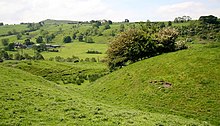Pilsbury Castle
Pilsbury Castle is an Outbound hilltop castle at Pilsbury in the English county of Derbyshire over the River Dove .
Details
Pilsbury Castle covered an area of approximately 160 meters by 137 meters on raised land near the village of Pilsbury. The castle was probably originally a fortification from the Iron Age before it was used by the Normans . In fact, the name "Pilsbury Castle" is made up of the Celtic Pil , the Anglo-Saxon Bury and the Norman Castel , all of which mean "fortified location" in German. In the early Middle Ages , the site was on the River Dove Routeway and also secured an important crossroads.
The Normans built a large moth on the site and opinions differ as to when they did so. One theory suggests that the castle was built in the years immediately following the conquest of England . The area around Pilsbury gave King William the Conqueror Henry de Ferrers a fief. This area was devastated at the Harrying of the North and Henry de Ferrers may have built the castle shortly after to regain control of the area. De Ferrers also had other castles built, e.g. B. Tutbury Castle and Duffield Castle , making Pilsbury Castle part of this 11th century group of defenses. An alternative theory is that the castle was built at the behest of Robert de Ferrers or his father during the Anarchy Civil War . While the De Ferrers supported King Stephen , their neighbor, Ranulph de Gernon, 2nd Earl of Chester , sided with Empress Matilda .
The castle itself consists of a mound and two courtyards with sides of about 40 and 45 meters respectively. The castle seems to have been abandoned again in the following years; but it can also be that it was destroyed after the participation of William de Ferrers, 3rd Earl of Derby , in the revolt of 1173–1174 or that it was abandoned when the surrounding land was passed to the Duchy of Lancaster after Robert de Ferrers, 6th Earl of Derby , had been expropriated. It is also possible that the castle was no longer needed because nearby Hartington gained importance and the village of Pilsbury became increasingly depopulated.
Little was seen of the castle in the 20th century; a mound on a limestone ledge and the remains of various earthworks were the only traces. At the beginning of the 21st century, the foundations of the castle were discovered during archaeological research. The site is a Scheduled Monument .
Individual evidence
- ^ John Charles Cox: Ancient Earthworks in William Page (editor): The Victoria History of the County of Derby . Volume 1. James Street, London 1905. p. 385.
- ↑ a b c d e f Pilsbury Castle . Gatehouse Gazetteer. Retrieved August 11, 2016.
- ^ G. Turbutt: A History of Derbyshire . Volume 2: Medieval Derbyshire . Merton Priory Press, Cardiff 1999.
- ↑ N. Landon, P. Ash, A. Payne, G. Phillips: Pilsbury: A Forgotten Castle in Derbyshire Archaeological Journal . Issue 126 (2006). Pp. 82-102.
Coordinates: 53 ° 10 ′ 15.2 " N , 1 ° 49 ′ 45.8" W.

